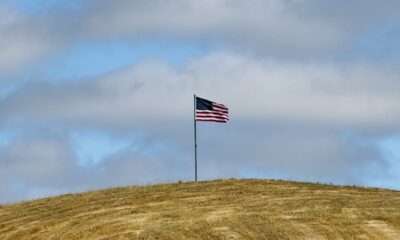Clergy
The Mystery of Governor Bradford’s Hebraic Gravestone
William Bradford, second Governor of Plymouth Colony, now has a marble obelisk marking his grave, with an interesting Hebrew phrase.

Standing on Burial Hill overlooking Plymouth Harbor, a marble obelisk marks the grave of Governor William Bradford (1590-1657), the longtime leader of Plymouth Colony. Etched on the stone are three Hebrew words that in English read, “God is the help of my life.” The inscription reflects Bradford’s Puritan piety and profound engagement with the Old Testament.
Governor Bradford at first didn’t have a gravestone
Yet the phrase itself does not appear anywhere in the Bible. Why commemorate Bradford with a pseudo-Scriptural citation? The story behind this forgotten artifact reveals surprising insights about the history and memory of Puritan New England.
For nearly two centuries, Bradford’s gravesite oddly languished in obscurity. In 1807, Yale’s president Timothy Dwight toured historic sites in Plymouth and meditated on the legacy of the colony’s founders. Paraphrasing a poem by Alexander Pope, Dwight lamented the lack of a marker for Bradford’s remains: “But not a stone / Tells where he lies.”
In his “History of the Town of Plymouth,” the physician James Thacher provided New Englanders the missing link to their colonial past: according to local folklore, a centenarian named Ebenezer Cobb reportedly recalled attending the funeral of Bradford’s son who had requested a burial spot next to the senior Bradford on Burial Hill.
Like Dwight, Thacher decried the disgrace to Bradford’s memory and called for the construction of a monument to celebrate “one of the principal founders of our empire.” Thacher’s appeal aligned with an emergent antiquarianism in New England. In 1835, a group of Bradford’s descendants decided to honor their ancestor at the location of his gravesite attested by the oral tradition. Interestingly, in a footnote in the second edition of his “History,” Thacher added that Cobb “was remarkable for facetiousness of disposition, and for a retentive memory.” Regardless of Cobb’s reliability, the spot on Burial Hill is the most plausible location for Bradford’s grave.
A different phrase?
A local newspaper, the Columbian Centinel, provided two key details about the monument’s creation. First, the inscription contained a different Hebrew phrase than the one currently carved into the stone: “[God] is the portion of my inheritance,” drawn from Psalm 16:5. Bradford himself had also placed the same words at the top of a theological manuscript he composed in 1652. Second, the monument’s foundation reportedly contained a stone from the house inhabited by Henry Vane and John Cotton, respectively a former governor and leading minister in the Massachusetts Bay Colony. This fusion of masonry symbolized the unity and amity between Plymouth and Massachusetts, which combined into a single province in 1691.
Bradford’s gravestone carried symbolic significance for antebellum New Englanders during a period of tumultuous politics. The bicentennial of Plymouth’s founding had coincided with the Missouri Compromise, in which Congress admitted Missouri as a slave state but carved out Maine from Massachusetts as a separate free state to retain sectional balance in the U.S. Senate. The memorial obelisk both reinforced regional identity amid national turmoil and commemorated Bradford’s spiritual journey.
Bradford’s own Hebrew studies
Around the same time he penned the phrase that later adorned his gravestone, Bradford began studying biblical Hebrew. In the opening pages of his manuscript history of Plymouth, he added an extensive Hebrew vocabulary and a series of scriptural citations. Bradford’s exercises reflected his deep desire to understand the Old Testament in its original language. Like many Puritans, he often turned to Scripture as a way to connect with God and used it as a lens through which to view the world.
The change from “portion of my inheritance” to “help of my life” remains a mystery. Was it an intentional reframing of Bradford’s legacy or simply a stonemason’s error during a restoration? By 1892, a published list of epitaphs on Burial Hill reproduced the current version of the text, which is visible in a photo from the 1920s. In the early twentieth century, Reform rabbi David Philipson visited the cemetery and observed a previous retracing in the stone. Ironically, the extant inscription evokes Bradford’s own experiments with Hebrew neologisms.
As Thanksgiving approaches, Americans often reflect on their Puritan past. The marble obelisk on Burial Hill, with its antebellum origins and evolving inscription, stands as a testament to Bradford’s legacy, the religious foundations of early New England, and the enduring relevance of historical memory.
This article was originally published by RealClearHistory and made available via RealClearWire.
Israel Benporat serves as a lecturer at Yeshiva University’s Straus Center for Torah and Western Thought and is a fellow with the Jack Miller Center. He holds a PhD in history from CUNY Graduate Center.
-

 Civilization4 days ago
Civilization4 days agoDC Pipe Bomb Arrest Raises Questions About Christopher’s Wray’s FBI
-

 Civilization5 days ago
Civilization5 days agoThe Legal Logic Behind U.S. Operations Against Narco-Terrorist Networks
-

 Executive5 days ago
Executive5 days agoNewsom’s ‘National Model’ for Homeless Wracked by Fraud
-

 Executive4 days ago
Executive4 days agoWhen You’re in a Hole, Stop Digging
-

 Executive2 days ago
Executive2 days agoWaste of the Day: Obamacare Failed Test, Approved Fraudulent Subsidies
-

 Education3 days ago
Education3 days agoWaste of the Day: Taxpayers Subsidize Football Coach Severance
-

 Civilization3 days ago
Civilization3 days agoPence Calls on Trump To Fire RFK Jr Over Abortion Drug
-

 Executive4 days ago
Executive4 days agoWaste of the Day: Feds Pay Nonprofits That Sue the Government












